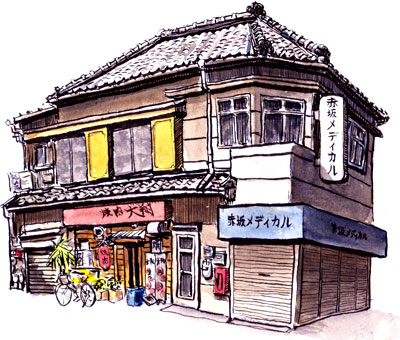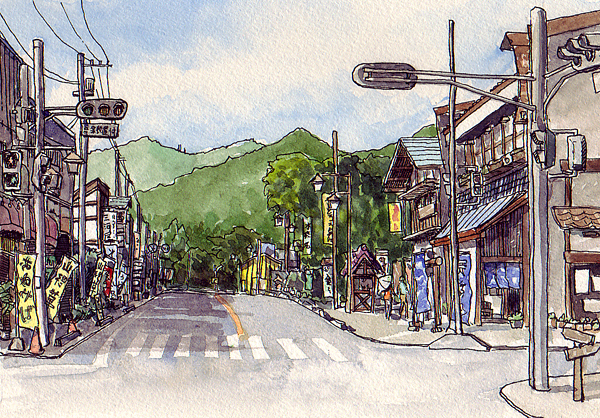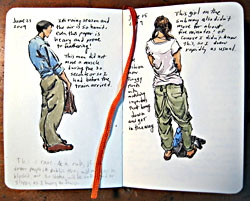 | ||
|
Page 10. Where, when and what to sketch (continued) Subject matter I mentioned the balance between finding comfortable sketching spots or interesting subjects. In light of this, there are basically two approaches to sketching. One is to seek out an interesting subject, and then sketch it from the most interesting vantage point.
Of course you may get lucky and find an ideal subject AND a comfortable place to sit, which would make you the luckiest sketcher in the world. Usually it's a matter of either finding interesting subjects worthy of sketching, or settling for dull subjects and trying to make them interesting. This second option is a worthy goal, and if we succeed at it, we will never run out of subjects, will produce lots of interesting sketches, and be able to sketch in relative comfort! Here is a secret: sketches are interesting to the viewer regardless of the subject matter, and you can make a sketch far more interesting than the subject ever was. Just transforming a three dimensional object in the real world into two dimensional art with line and color is enough to make it exciting. It doesn't matter if the sketch was drawn quickly and scribbly. If you take a photo of a subject and also sketch it, I'm sure the sketch will turn out to be far more interesting than the photo. If you can see the potential for an interesting sketch in dull subjects, then you won't have to go far from home. I mentioned above the idea of taking walks in your neighborhood with a sketchbook. This will be a rewarding sketching experience if you are willing to turn every day mundane subjects into sketches.
I am fortunate to live in Tokyo where a lot of neighborhoods have great sketch subjects such as old temples and shrines. But I also see lots of potential subjects that don't appear so interesting at first glance, things like entrances to parks, stairs, trees, doorways, old houses, or cars. I would include flowers in this category but somebody might shoot me for calling flowers mundane. Personally I don't have much interest in flowers, but flowers are everywhere, and are fantastic sketch subjects. They have lots of great natural contours and no boring straight lines. They allow you to use those bright colors in your palette that usually go unused. I'll go a step further and say that dull subjects often make better sketches! Have you ever tried to draw a famous landmark, a famous person or even a pretty face only to find that you couldn't do it well because you tried too hard? You really wanted to stay accurate with the details or do the subject justice, and as a result, fear and intimidation entered, and you probably became frustrated. Famous Landmarks such as Nikolai Cathedral in Tokyo can be intimidating. But just unleash those art talents on sketching an old shack or face you will never see again or an ugly person or animal, and see how well the sketch turns out. It doesn't matter if the proportions and details are not the same as the real thing, or the colors don't match; you produced something that is interesting, and it will give a thrill the next time you open your sketchbook and take a fresh look at it. Famous landmarks Of course, you don't have to avoid famous landmarks. You always have the choice of rendering them faithfully or sketching your own creative interpretation of them. Other artists and photographers have accurately portrayed them countless times in the past, so there is no pressure for you to follow their footsteps unless you want to. A long time ago artists had more reason to record accurately what they saw. They were the cameras of the world, and anything less than an accurate representation probably seemed like a waste of time and materials. But the invention of the camera changed all that. We can accurately record the world if we want to, be we are also free to create art based on life as we perceive or imagine it. Of course, if you are the type who likes to draw purely from imagination, or use real life subjects as a springboard for soaring off into the wild world of fantasy, then you are probably shaking your head at all this talk on finding a place to sketch; you have found the ideal place in your own head, and it doesn't much matter where you happen to be! "Don't bite off more than you can chew" is a wise maxim for busy people who want to sketch. Sometimes you may have the time and energy to sketch something as complex as an entire street scene with all its details and challenging perspective lines. Other times you may want to just pick out elements from the scene in front of you and draw those. You may have to search a while for an entire scene that appeals to the artist in you, while those isolated objects that make interesting sketches can be found everywhere. If you only have a short time to sketch, choose something very simple. Mountain and valley subjects In terms of complexity, I have found two kinds of subjects, mountain subjects and valley subjects. These are my own ideas, and I hope they make sense to you.
An isolated object such as a still life, a person or group or people, even a building on a corner can be mountain subjects. Naturally, some mountains such as Japan's Mount Fuji can be mountain subjects. A mountain subject is fun to draw and can have a lot of impact. If you collect objects as sketches, and think of your sketchbook as a collector's shoe box, then it will be full of mountain subjects. My pocket size hard bound sketchbook is full of mountain subjects; mostly quick sketches of people I see on the train. I guess I collect people, and each is isolated in its own place like a butterfly on a pin. The sketch below of isolated building is a mountain subject. It was on a street corner. I could have included the background but I decided to omit it. If I were to dedicate a sketchbook to examples of old Japanese architecture, it might be full of mountain subjects like this one.  A valley subject, on the other hand, is an integral part of its surroundings and can't be extracted. Valley subjects are more effective for evoking feeling in the viewer since they can draw you into a scene. Street scenes which include trees or buildings are valley subjects. Room interiors are usually valley subjects. The Grand Canyon would be a valley subject. The sketch below of a street scene on a hot summer day is a valley subject. Everything is overlapping something else, and the whole scene becomes the subject.  Mountain subjects are generally easier to tackle than valley subjects because you can focus entirely on the subject rather than its surroundings. You can choose to include the background or omit it entirely. Valley subjects are more complex and take more time and energy and planning, but if you succeed, they can have a greater emotional impact than a mountain subject. |
Next page >> |
 |
 A mountain subject is one that can stand on its own without the background. If you wanted to, you could surround it with white space for an interesting and simple sketch.
A mountain subject is one that can stand on its own without the background. If you wanted to, you could surround it with white space for an interesting and simple sketch.